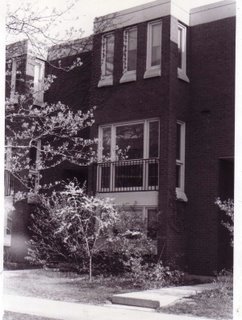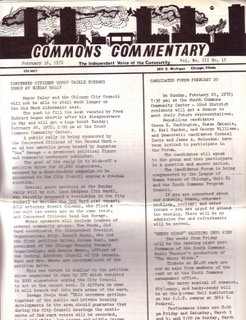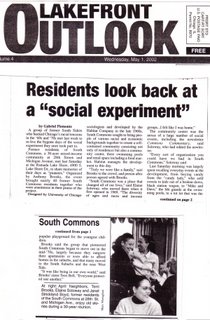
In 1969, one year after the assassination of Dr. Martin Luther King, Jr., and when riots erupted in parts of the inner city, my husband and I and our two young daughters moved from suburban Glenview to South Commons, a 30-acre, urban renewal complex at 28th St. and Michigan Ave. on Chicago’s Near South Side.
Friends and relatives called us crazy, but that move changed me. The 31-year-old unhappy housewife I was back then turned into a newspaper editor, musical theatre producer, and community activist. Almost overnight, I shed bored and lonely and donned euphoria.
I got to thinking about the 10 years I spent in South Commons after I had written my Aug. 31 post declaring the years described in my memoir, "The Division Street Princess,"as the most influential in my life. While the impact of my childhood above the store still holds true, South Commons is the place I hold nearest my heart -- the answer to all my dreams.

In many ways, the move to South Commons was a homecoming because we had previously lived nearby at Prairie Shores, when my husband was a resident at Michael Reese Hospital. But once he completed his tour, a job at an Arlington Heights hospital and the natural path of a Jewish doctor and his young family, prompted a move to a tract housing development more than 20 miles from the city.
For many – especially my mother – our suburban three-bedroom raised ranch with yard and attached garage on a cul-de-sac ringed with skinny baby trees, was heaven. For me, it was not. I felt fish-out-of-water, unable to connect to neighbors who were my age, religion, and background. I missed the city and would regularly sit on a bus for 1-1/2 hours to reach State and Madison.
Fortunately, my husband switched medical specialties and won a residency in Chicago that required a move back. When I learned about South Commons, a “new town” just a few blocks from our old Prairie Shores apartment, that aimed to integrate races, incomes, and ages in a mix of for-sale townhouses and rental low-, mid-, and high-rise buildings, I wanted in.
From my first step into the South Commons community center, where some boisterous activity was underway, I felt at home. As soon as moving boxes were unpacked, I plunged in, becoming a volunteer for Rev. Ed Weisheimer, a Disciples of Christ minister who led the ecumenical South Commons Church and organized community activities.

On a Selectric typewriter, I tapped out weekly issues of the Commons Commentary, rolled dotted pages onto a mimeograph machine, and delivered copies that had been piled onto a red Flyer wagon, to an eager audience of readers. I was a writer, editor, and publisher – skills unknown to me that blossomed freely in South Commons’ fertile soil.

I believe my family thrived, too. My husband played leads in The Sorcerer, Pirates of Penzance, Carousel, and other musicals produced by our amateur theatre group; and he flourished in his medical career. At times, though, I imagine he longed for the housewife he had married only nine years earlier. But she had disappeared, and in her place was a woman barely recognizable to the two of us.

Our daughters Faith and Jill caught the show biz bug, too, while acting in the chorus of these musicals and in rag-tag productions they created in our courtyard playground. (You can read Jill’s take on South Commons in her book of essays, Tiny Ladies in Shiny Pants.)

Local and national publications put our neighborhood under a microscope: The Chicago Daily News claimed, “South Commons meets big test” (Oct. 17, 1969). The Christian Science Monitor said, “The experimental ‘new town’ in Chicago’s South Side is a model for cities seeking to reverse urban decay.” (April 23, 1971). The Chicago Daily News praised, “the integrated way of life in South Commons” (Sept. 29, 1972), and The Chicago Sun-Times described, “A sense of community at South Commons” (Sept. 10, 1972).

Much later, I was gratified to learn that along with my own family, and the journalists who penned those stories, other South Commons’ residents praised the community’s positive impact. In 2002, Tony Brooks, (you can read his reporting in the Aug. 4 archive of Chicago Sports Review) a young black man who had lived in a South Commons rental apartment in the 1970s, organized a reunion he targeted “to the kids who grew up in one of the best neighborhoods Chicago has to offer.” Although I was decades older than Tony and his peers, I attended the gathering and listened as Tony and his old South Commons friends shared my view that our experience had been a blessing.
Some former residents, who had moved out of town and missed the reunion (including my daughters) sent e-mails relating their memories. Mardi Teale, one of my best South Commons friends, who worked on the Commons Commentary, and with her husband, Jim, painted scenery or designed costumes for the musical theatre troupe, wrote from Arizona: “The best part of life there was the community spirit – people of all ages and ethnicity living, working and playing together. Of all the places we’ve lived, South Commons provides the best memories of all.”
My family remained in South Commons until 1979, long after many of our neighbors had left, after Faith and Jill were nearly the last white children in the K-6 branch of Drake elementary, after the early dream of integration had faded. Some of the middle-class black and white families left because they refused to send their children to “big Drake” for 7th and 8th grades where they would mix with the kids of nearby public housing. Others moved for typical reasons: because they needed more or less space than their South Commons residences provided, for affordable suburban homes, or for job opportunities elsewhere.
Forever touched by my South Commons experience and encouraged by its developer Daniel Levin and architect Ezra Gordon, I entered the very first Masters of Urban Planning Program at the University of Illinois Chicago. I wanted to learn what had happened to the noble experiment. What worked, what failed? I interviewed parents who had welcomed social integration for themselves, but rebelled at using their children as laboratory subjects in the public schools. Their stories form the basis of my master’s thesis.
Today, the Near South Side is bursting with new real estate and a mix of residents, and South Commons remains a centerpiece. My former homestead is all grown up now, no longer a “social experiment,” simply a lushly landscaped oasis in the city, 2-1/2 miles from Chicago’s downtown.
The dreams of wild-eyed urban pioneers -- like Tony Brooks, Mardi Teale, me, and so many others – are tucked in scrapbooks and photo albums. But every so often, especially when I hear old ‘70s tunes, like this one from Barry White, I go right back to those very special days:
The first, the last, my everything
And the answer to all my dreams
You're my sun, my moon, my guiding star
My kind of wonderful, that's what you are
I know there's only, only one like you
There's no way they could have made two
You're all I'm living for
Your love I'll keep for evermore
You're the first, you’re the last, my everything
Photo Captions:
No.1. From Chicago Sunday Sun-Times, Midwest Magazine, June 28, 1970.
No. 2. Our South Commons townhouse.
No. 3. An issue of the Commons Commentary, Feb. 16, 1972.
No. 4. From The Herald newspaper, April 25, 1973.
No. 5. South Commons’ kids in the courtyard. Jill at the drum, and Faith to her right.
No. 6. Friends and neighbors, from left to right: Friends Linda, Faith, Vaso, Jill, and Gina.
No. 7. From Lakefront Outlook, May 1, 2002.
15 comments:
Oh wow, that song took me back. I wanted to leave a comment but I had to wait until the audio clip finished! Thanks for that.
Andrew
To Love, Honor and Dismay
I vaguely remember visiting you on the South Side on a family trip to Chicago when I was probably about 9 years old (give or take a year). The main thing I remember is the pool at your complex.
Elaine--you continue to amaze me with your writing skill ,energy, astute memory and wonderful relationship with the girls. Keep it up!.
Don
I loved your story about South Commons and I wanted to see more pictures. Do you have any of what it looks like today?
xo Your daughter's neighbor
Mary
Hi Elaine
What a nice job of describing our time in South Commons. A reminder of so much that was happening then. I think I was somewhat on the edge. Busy being a housewife! I'm still amazed a how much some people (like You) are able to take on. To our advantage.
Thanks for including me in your blog. I've sent it on to Joanne. Not cause I'm on it but I know she'll enjoy it.I'll also send it to Sarah and Rachel.
See you soon.
Vaso
Elaine--
This a well-told story. Thanks. The photos are good too!
(Did Dick Christiansen live in South Commons while you were there?)
--Marshall
you are marvelous, Elaine,
i loved this past piece too
danny
Elaine,
So glad you decided to write about SoCommons experience It also changed my life - from guilt-ridden
divorcee to active, involved, happy person. Without a doubt, it was one of the happiest periods of my life, alas, never to be repeated. Keep writing abou it, love,
Isolde
Dear Elaine,
I was teaching at Beethoven (47th and State) during those years. (1962-1975) We frquently went to a restaurant in South Commons, and several of staff memvers lived there too. The restaurant name and teachers names will come to me as soon as I click "Send"
Wait a minute, was the restaurant Mr. Stevens?
--
Greg
Elaine,
Thanks for keeping me up to date on your posting, please keep the updates coming. So fun to see those old pictures. I still have not tracked down your thesis, but remain interested. I'm excited to hear about your book. Are you doing readings? Please let me know if you are doing anything in NYC I would love to have the chance to hear you read and visit.
I am still working on the writing project I told you about on your visit to New York. In fact right now I am distracting myself from working on a the application for a grant aimed at artists writing on the arts. I would love to get a little financial support for the writing project (mmmm new computer), but more then that I am hoping to get the grant because then I can point to it as a sign that this part of my production is legitimate - right now it is not a part of what people associate when they think about my art work. Its a hobby.
Warmest regards,
John
I moved to south commons as a as a 5 yr old in 1973. we were the mortons.now fourty and have fond memories
I loved reading this! My family (the Hudsons)lived in South Commons from 1969 until 1971 while my father was attending the University of Chicago, and we were members of Ed Weisheimer's church (I believe my parents still exchange Christmas cards with he and Ann). My mother was in three G&S musicals, including "The Pirates of Penzance," and she had the lead in "The Gondoliers." I attended rehearsals with her often.
I found my sister, Jenny, in one of your pictures.
I can't tell you how much this takes me back to a time that was both terrifying and exciting. I still dream about the neighborhood, our apartment, and the church. What a vibrant and colorful place it was!
Hi Laura,
I loved receiving your comment. Please write to me at elainesoloway@gmail.com so we can correspond.
Best,
Elaine
I don't know if you remeber me - but I'm George Sims. Just came across your blog and it bring bavk fond memories. Anyway - if you get this, I wish you and your family well.
Of course I remember you, George, and your wonderful parents. Please send me an e-mail at elainesoloway@sbcglobal.com so we can keep in touch.
xoxo
Post a Comment